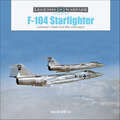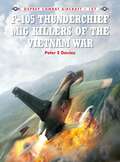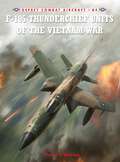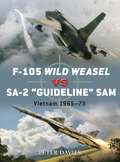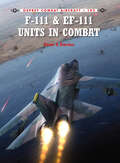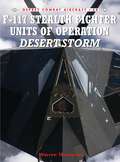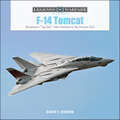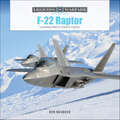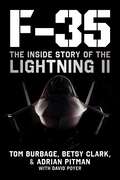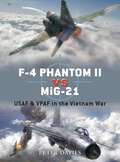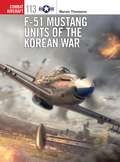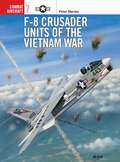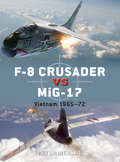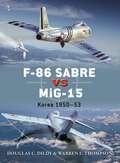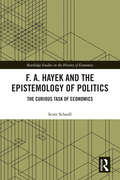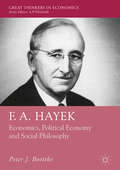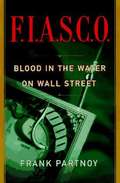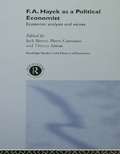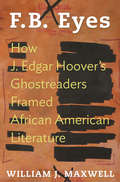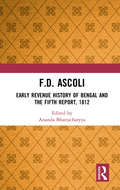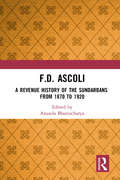- Table View
- List View
F-104 Starfighter: Lockheed's Sleek Cold War Interceptor
by David DoyleThe F-104 served with fifteen major international Air Forces
F-105 Thunderchief MiG Killers of the Vietnam War
by Jim Laurier Peter DaviesUSAF Rolling Thunder strike missions tactically assaulted North Vietnamese defenses, overcoming MiG fighter jets and SAM (surface to air) missiles to devastate North Vietnam's industrial base strategically. Despite its "F-for-fighter" designation, the F-105 was designed and purchased to give the USAF an aircraft for delivery of nuclear weapons at very high speed, long range and below-the-radar altitudes. When the Vietnam War began, it was the USAF's best available tactical bomber for a "limited conventional" war as well. From 1964 to 1968 it flew the majority of bombing missions against North Vietnam, performing an effectively "strategic" role in assaulting North Vietnam's industrial and military heartland. Thunderchief crews faced North Vietnamese MiG-17s and MiG-21s more often than any other US flyers. Large formations of F-105s came under frequent attack by MiG pilots, and the F-4 Phantom II escorts that were meant to protect them were not always in the right position to fend off the attackers. F-105 crews would then defend themselves using their internal 20 mm cannon and occasionally AIM-9B Sidewinder missiles. Although their fighters were far larger, heavier and much less manoeuvrable than the adversarial MiGs, the F-105 pilots used speed and skill to down 27.5 MiG-17s - a tally in excess of that scored by USAF F-4 Phantom II crews in the same period between June 1966 and December 1967! In most cases the F-105 pilots concerned also succeeded in dropping their ordnance on targets during the same sorties.
F-105 Thunderchief Units of the Vietnam War
by Jim Laurier Peter DaviesThe F-105 was a supersonic fighter-bomber used by the USAF to great extent during the Vietnam War (1955-1975). Despite pilots' initial apprehensions about the aircraft and a variety of problems with early designs, these planes ultimately became the primary strike bomber over North Vietnam in the early stages of the Vietnam War. This book explores the crucial importance of the Thunderchief, deemed the "Thud" by many of its crews, in the Rolling Thunder campaign; it explains the pioneering suppression of enemy air defences (SEAD) methods developed by the F-105 'Wild Weasel' crews. Using first-hand narratives wherever possible, the text captures the essence of flying the "Thud" against heavy AAA, SAM and MiG defences in conditions where constricting Rules of Engagement made the pilots' task virtually impossible at times. The book also documents the other demanding missions flown over Laos and South Vietnam. The author also gives an extensive overview of the aircraft's strengths and difficulties, the development of wartime tactics and the heroic accomplishments of a selection of its aircrew.
F-105 Wild Weasel vs SA-2 'Guideline' SAM
by Jim Laurier Peter DaviesAlthough America entered the Vietnam War with some of the world's most sophisticated combat aircraft, the majority of their missions involved conventional bombing and fighter engagements that employed quite similar tactics to those previously used in the Korean War and World War 2. The real step change in aerial fighting came with the use of air-to-air and ground-to-air missiles. Developing methods of defeating the latter involved the rapid evolution of technology and tactics which, over twenty years later, would enable the USA to win the air war over Iraq in Operation Desert Storm in a matter of hours. During the Vietnam War, the appearance of Russian SA-2 missiles around Hanoi in 1965 alarmed US officials. Initially reluctant to attack the missile sites, the increasing toll of US aircraft and the ways in which the SA-2s inhibited bombing tactics meant that new methods of dealing with the sites had to be developed quickly. Electronic reconnaissance aircraft had some success with jamming of the missiles' guidance systems at long range, but the real solution lay with an aircraft that could detect the radars at closer range, offer itself as a target to the missile sites and attack them before missiles could be launched at US bombers. F-105Fs equipped with new technology quickly became an essential addition to all USAF strike missions over North Vietnam. Using new Shrike and Standard ARM anti-radiation missiles and radar detection equipment developed by the US Navy, the F-105F and its more sophisticated successor, the F-105G, continued their hair-raising battles with North Vietnamese missile batteries throughout the rest of the Vietnam War. Here, author Peter Davies recounts the dramatic contests between these newly outfitted F-105s and the missile sites in Vietnam in a highly illustrated account, drawing on first-hand pilot experiences and technical manuals to present a full history of the technologies and tactics of both sides.From the Trade Paperback edition.
F-111 & EF-111 Units in Combat
by Peter Davies Rolando UgoliniThe General Dynamics F-111 was one of the most technically innovative designs among military aircraft, introducing the variable-sweep wing, terrain-following radar, military-rated afterburning turbofan engines and a self-contained escape module among other features. Designed as a cost-saving, multi-role interceptor, naval fighter and strike bomber, its evolution prioritised the latter role and it became the USAF's most effective long-range strike aircraft during three decades of service. Rushed into combat in Vietnam before some of its structural issues were fully understood, the type suffered several early losses and gained an unfairly negative reputation that dogged it for the rest of its career, and restricted funding for more advanced versions of the design. However, in Operation Linebacker in 1972 the F-111 flew 4000 nocturnal under-the-radar missions, delivering, with unprecedented accuracy, many decisive blows that would have resulted in heavy losses for any other attack aircraft. Post-war, F-111E/F variants were concentrated in two USAFE wings in the UK, and one of these was chosen in April 1986 to deliver a punitive strike on Libya in response to a series of terrorist attacks on US targets in Beirut and Europe. The 48th Tactical Fighter Wing (TFW) flew a 14-hour mission direct from its Lakenheath base, hitting several military targets around Tripoli. Five years later both UK-based wings, including their sophisticated EF-111A defence suppression aircraft, led the attack on the first night of Operation Desert Storm, decimating Iraq's huge military capability. For the rest of the campaign the F-111s were crucial in destroying bridges, airfields and deep-seated command bunkers with pinpoint accuracy using laser-guided munitions.
F-117 Stealth Fighter Units of Operation Desert Storm
by Mark Styling Warren ThompsonDuring the final years of the 20th century, the most significant break-through in military weaponry was the concept of Stealth technology, and the first mass-produced weapon to utilize this to perfection was the F-117 Nighthawk. Originally delivered in 1982, its existence was officially denied until the Iraqi invasion of Kuwait, when it entered the public spotlight over the skies of Baghdad. Illustrated with stunning color photographs of the F-117 above Iraq, and complemented by numerous personal accounts from the pilots themselves, this book explores the history and combat experience of one of the most secretive planes ever built.
F-14 Tomcat Units of Operation Enduring Freedom
by Jim Laurier Tony HolmesThe legendary F-14 Tomcat was the weapon of choice to strike hard and fast against the enemies of the United States in the wake of the September 11 attacks. Determined to hit the al-Qaeda bases within Afghanistan, US plans were hampered by the reluctance of neighboring countries to allow US military aircraft to operate from their land bases. This meant that carrier-based F-14s were forced to fly several hundred miles a day to reach their targets, flying thousands of missions involving precision bombing strikes on al-Qaeda and Taliban positions. A fascinating exploration of modern air warfare, this book details the actions of the F-14 pilots and aircraft involved in Operation Enduring Freedom (2001-present) with eye-opening insights into the tactical approach and wider strategic aims exclusively provided by senior officers from a number of the air wings involved. Written by a leading Tomcat expert with exclusive access to mission reports, combat diaries, first-hand accounts and accompanied by photographs from the author's private collection and fantastic full-color artwork, this reveals the battle experiences of the most famous modern fast jet.
F-14 Tomcat: Grumman's “Top Gun” from Vietnam to the Persian Gulf (Legends of Warfare: Aviation #11)
by David F. BrownAn illustrated history of the iconic aircraft, from its service during wartime to its appearances in Hollywood, plus a study of its design & construction. It has been said that &“bombers make history; fighters make movies.&” In the case of the Grumman F-14 Tomcat, both are true. It made history as a fleet defender, reconnaissance platform, and strike fighter. The Tomcat was also featured in such Hollywood classics as Top Gun, The Final Countdown, and Executive Decision, followed by television appearances on JAG. This new illustrated look at the iconic Tomcat features a concise, detailed look at its design and construction, followed by its service in the U.S. Navy from 1975 to 2006. Also covered is a rare look at its use by the Imperial Iranian Air Force, and continued use by the Islamic Republic of Iran Air Force. All USN units that flew the Tomcat are featured, including squadron patches, markings, and nose art. Combat operations are discussed, including aerial combat over Libya, Iraq, and Afghanistan. Part of the Legends of Warfare series.
F-22 Raptor: Lockheed Martin Stealth Fighter
by Ken NeubeckAn up-to-date pictorial guide to the most deadly production fighter aircraft in the world
F-35: The Inside Story of the Lightning II
by David Poyer Tom Burbage Betsy Clark Adrian PitmanThe inside story of the most expensive and controversial military program in history, as told by those who lived it. The F-35 has changed allied combat warfare. But by the time it&’s completed, it will cost more than the Manhattan Project and the B-2 Stealth Bomber. It has been subject to the most aggressive cyberattacks in history from China, Russia, North Korea, and others. Its stealth technology required nearly 9 million lines of code; NASA&’s Curiosity Mars rover required 2.5 million. And it was this close to failure.F-35 is the only inside look at the most advanced aircraft in the world and the historic project that built it, as told by those who were intimately involved in its design, testing, and production. Based on the authors' personal experience and over 100+ interviews, F-35 pulls back the curtain on one of the most heavily criticized government programs in history from start to finish: the dramatic flights that won Lockheed Martin the contract over Boeing; the debates and decisions over capabilities; feats of software, hardware, and aeronautical engineering that made it possible; how the project survived the Nunn-McCurdy breach; the conflicts among all three branches of the U.S. military, between the eight other allied nation partners, and against spy elements from enemies. For readers of Skunk Works by Ben Rich and The Making of the Atomic Bomb by Richard Rhodes, F-35 will pique the interest of airplane enthusiasts, defense industry insiders, military history aficionados, political junkies, and general nonfiction readers.
F-4 Phantom II vs MiG-21
by Jim Laurier Peter Davies Gareth HectorFrom difficult weather conditions to unreliable missile armament to unequal rules of engagement, this book tells the story of the challenges faced by the F-4 and MiG-21 pilots. Using first-hand accounts wherever possible the author draws us into the dangerous world experienced by American and North Vietnamese pilots. Influential leaders and tacticians will be profiled to provide a comparative evaluation of their contrasting skills. This book will also reveal the technical specifications of each jet with an analysis of the weaponry, avionics and survival devices of the Phantom and MiG-21. The fighters' strengths and weaknesses will be compared also, including turn radius, performance at altitude, range and structural integrity. This was an intense and deadly duel between vastly different rivals. In the Phantom, a second crewmember and good radar compensated for the difficulty of providing command and control at long distances from the targets. However, the F-4's smoky engines and considerable bulk made it visible at much further distances than the small, clean MiG-21 and Phantoms were often hit by unseen MiG attacks. On the other hand, the F-4s eight-missile armament compared favorably with the two-missile provision of the MiG. Often pilot skill, if not luck, would be the determining factor between the smaller, faster MiG and bigger, better-gunned Phantom. First-person extracts will reflect on the dangers of these aerial duels while graphics based on records of engagement and technical manuals will illustrate the experience of air combat as they struggled to overcome their shortcomings and survive their deadly duels.
F-51 Mustang Units of the Korean War
by Chris Davey Warren ThompsonBy the time the Korean War erupted, the F-51 Mustang was seen as obsolete, but that view quickly changed when the USAF rushed 145 of them to the theatre in late 1950. They had the endurance to attack targets in Korea from bases in Japan, where the modern F-86 fighters and other jets did not. Rather than the interceptor and escort fighter roles the Mustang had performed during World War 2, in the Korean War they were assigned to ground attack missions - striking at communist troop columns advancing south. This is the chronicle of the Mustang units that fought in the Korean War, detailing the type's involvement in a series of intense actions, its successes and its considerable losses. Drawing on meticulous research and gripping first-hand accounts from aircrew, this book explains how the faithful Mustang was able to roll back the years, fight, and prove itself in a new era of aerial warfare.
F-8 Crusader Units of the Vietnam War
by Tom Tullis Peter MerskyOsprey's study of the role played by F-8 Crusader Units in the Vietnam War (1955-1975). Known to its pilots as the 'last of the gunfighters' due to its quartet of Colt-Browning Mk 12 20 mm cannon, the F-8 Crusader was numerically the most populous fighter in the US Navy at the start of America's involvement in the Vietnam conflict in 1964 - some 482 F-8C/D/Es equipped 17 frontline units. It enjoyed great success against North Vietnamese Mig-17s and Mig-21s during the Rolling Thunder campaign of 1965-68, officially downing 18 jets, which represented 53 per cent of all Mig claims lodged by Navy squadrons during this period.
F-8 Crusader vs MiG-17
by Jim Laurier Peter MerskyThis book covers the actions fought between two of the best known fighters of the Vietnam War, in action over the North during the early years of the conflict.Revered by Naval Aviators as the "last of the gunfighters" due to its quartet of Colt-Browning Mk 12 20 mm cannon (its great naval rival, the F-4 Phantom II, was exclusively armed with missiles), the F-8 Crusader enjoyed great success against VPAF MiG-17s during the Rolling Thunder campaign of 1966-68. The fighter was credited with 18 kills, 14 of which were MiG-17s. Things did not go all the Crusader's way, however, as VPAF pilots used the MiG-17's unequalled low-speed manoeuvrability, small size and powerful cannon armament to take the fight to their gun- and missile-equipped foes. The North Vietnamese pilots claimed ten F-8s and one unarmed photo-recce RF-8 shot down, although only four of these successes could be matched with known US Navy losses. Nevertheless, the duels fought between these two aircraft were some of the hardest of the war, as the Crusader pilots did their level best to defend vulnerable carrier-based attack aircraft striking at targets deep in North Vietnam.
F-86 Sabre Aces of the 4th Fighter Wing
by Mark Styling Warren ThompsonThe entry of the United State's premier jet interceptor into the Korean War was triggered by the ever-increasing presence of the Soviet-built MiG-15 south of the Yalu River. The possibility of the USAF losing air supremacy over the Korean Peninsula was unacceptable. The 4th Fighter Wing got the call for combat in Korea. They were made up of a combination of new pilots right out of jet training and the older combat veterans of World War II vintage. This combination of pilot types wrote and re-wrote the text books on jet warfare. Of the 40 jet aces that the war produced, the 4th Wing boasted 24 of them. They also were the dominating MiG killer outfit with the USAF.
F-86 Sabre Aces of the 51st Fighter Wing
by Mark Styling Warren ThompsonThe 51st Fighter Wing initially flew the F-80C in the Korean War, but in 1951, the 51st brought in high-scoring World War 2 ace Colonel Francis Gabreski to assume command when it converted from the F-80 over to the newly arrived F-86E. His recruits included his elite 4th Wing pilots, and by the end of the war, the 51st had two pilots who achieved the status of "Double Ace" as well as the highest scoring ace of the war, Joe McConnell. This book describes the 51st Wing's tenure with the Sabre that led to their high scoring sprees of 1953.
F-86 Sabre vs MiG-15
by Jim Laurier Doug DildyAs the routed North Korean People's Army (NKPA) withdrew into the mountainous reaches of their country and the People's Republic of China (PRC) funneled in its massive infantry formations in preparation for a momentous counter-offensive in the last months of 1950, both lacked adequate air power to challenge US and UN air supremacy over both the battlefields and the logistics channels from China into North Korea. Reluctantly, Josef Stalin agreed to provide the requisite air cover, introducing the superior swept-wing MiG-15 to counter the American's straight-wing F-80 jets and to repel the United States Air Force (USAF) B-29 bomber formations that were interdicting the PRC's flow of troops and supplies into North Korea. This in turn prompted the USAF, against its conventional wisdom of retaining its first-line air-defence fighters to face Soviet air forces across the 'Iron Curtain' in Europe, to deploy its very best - the F-86A Sabre - to counter this threat. Thus began a two-and-a-half-year struggle in the skies over a corner of North Korea known as "MiG Alley."In this period, the unrelenting campaign for aerial superiority witnessed the introduction of successive models of these two revolutionary jets - the MiG-15bis, the F-86E, and eventually the F-86F - into combat. It also saw the transition of operational leadership on the communist side from the Soviet "volunteers" to the newly formed Chinese PLAAF air divisions, and witnessed the re-introduction of the NKPAF, with its "just trained" MiG-15 units, into the air-combat arena. This meticulously researched study not only provides technical descriptions of the two types and their improved variants, complete with a "fighter pilot's assessment" of these aircraft, but also chronicles the entire scope of their aerial duel in "MiG Alley" by employing the recollections of the surviving combatants - including Russian, Chinese, and North Korean pilots - who participated.
F. A. Hayek and the Epistemology of Politics: The Curious Task of Economics (Routledge Studies in the History of Economics)
by Scott ScheallF. A. Hayek and the Epistemology of Politics is an exploration of an important problem that has largely been ignored heretofore: the problem of policymaker ignorance and the consequences of limited political knowledge. Scott Scheall explores the significance of the fact that the possibilities for effective political action are constrained by policymakers’ epistemic limitations. The book offers an explanation for why policymaking often fails and why constituents, whatever their political affiliations, are so often disappointed with political leaders. In this philosophical examination of his work, Hayek’s ideas are not merely discussed, analyzed, and contextualized, but extended; the book both draws and defends previously unrecognized implications from the Hayekian canon. The book will be of interest to scholars of the works of F. A. Hayek and his intellectual adversaries, to policymakers, and to those of all political, philosophical, and social-scientific persuasions.
F. A. Hayek: Economics, Political Economy and Social Philosophy (Great Thinkers in Economics)
by Peter J. BoettkeThis book explores the life and work of Austrian-British economist, political economist, and social philosopher, Friedrich Hayek. Set within a context of the recent financial crisis, alongside the renewed interest in Hayek and the Hayek-Keynes debate, the book introduces the main themes of Hayek’s thought. These include the division of knowledge, the importance of rules, the problems with planning and economic management, and the role of constitutional constraints in enabling the emergence of unplanned order in the market by limiting the perverse incentives and distortions in information often associated with political discretion. Key to understanding Hayek's development as a thinker is his emphasis on the knowledge problem that economic decision makers face and how alternative institutional arrangements either hinder or assist them in overcoming that epistemic dilemma. Hayek saw order emerging from individual action and responsibility under the appropriate institutional order that itself emerges from actors discovering new and better ways to coordinate their behavior. This book will be of interest to all those keen to gain a deeper understanding of this great 20th century thinker in economics.
F. I. A. S. C. O.: The Inside Story of a Wall Street Trader
by Frank PartnoyA former derivatives salesman takes readers onto the trading floor of a leading investment bank and in a tell-all, no-holds-barred expose, reveals for the first time the ugly truth about these complex financial products and the people who peddle them. Writing with the same eye for telling details as Michael Lewis in Liar's Poker, Frank Partnoy shows how the once genteel world of investment banking has now become a place where the rallying cry is "There's blood in the water. Let's go kill someone." Partnoy was in his late twenties when he landed the job of his dreams a position in Morgan Stanley's Derivatives Products Group, the single most profitable division of the venerable investment bank. With vivid character sketches and a wealth of funny-yet-disturbing anecdotes, Partnoy takes us inside the culture of Morgan Stanley's derivatives group. Encouraged by upper management and egged on by gun-toting senior salesmen, derivatives had become a business-as-war, take-no-prisoners operation where people pored over Soldier of Fortune and gloated when they sold a product that "ripped off" a client's face. As he leads us through the ups and downs of his fifteen months at Morgan Stanley, Partnoy explains in plain English what derivatives are and shows how he and the other "rocket scientists" at the bank custom-designed these arcane financial products to dodge government regulators, encourage foreign currency speculation by pension and mutual funds, disguise risky gambles with AAA Standard & Poor's ratings, and avoid capital gains taxes for wealthy individuals. He also details, for the first time, the deal that earned Morgan Stanley the fattest fee in Wall Street history a $74.5 million profit for devising a derivative that wiped hundreds of millions in losses off a Japanese company's balance sheet. But dreaming up ever more complicated derivatives products Dollarized Yield Curve Notes, Constant Maturity Treasury Floaters, Trigger Notes, and Total Return Swaps, to name a few was never enough. For the bank to earn its fee, they had to be sold usually, as Partnoy notes, either to "cheaters" (fund managers who wanted riskier investments than their regulators or charters normally allowed) or to "widows and orphans" (unsophisticated fund managers who couldn't understand the risks in fine print). Throughout the book, Partnoy gives us a trading-floor view of the disasters fueled by derivatives trading and provides the formula of greed, daring, and ingenuity that are the basic ingredients of all derivatives. Written with humor, insight, and a mounting sense of moral outrage, F.I.A.S.C.O. is both a brilliant insider's account of investment banking today and a blistering indictment of the largely unregulated market in derivatives a book that everyone who has a pension plan or invests in mutual funds needs to read.
F. Scott Fitzgerald (Literature and Life)
by Rose A. GalloF. SCOTT FITZGERALD captured for all time the feverish gaiety, the high expectations, the small disappointments of the Roaring Twenties--and in the process his own life became an American legend. Some critics have said that Fitzgerald’s writing declined after The Great Gatsby. Rose Gallo takes exception to that view. In this refreshing introduction to Fitzgerald’s work, she traces the development of all of the writer’s novels chronologically--from This Side of Paradise (1920) to The Last Tycoon (published posthumously, 1941)--and examines with a discerning eye some of his major short stories. Fitzgerald’s fiction, writes the author, was shaped not only by the 1920s but by the grander, more enduring mythologies of the past. Author Rose Adrienne Gallo is Associate Professor of English at Seton Hall University.
F.A. Hayek as a Political Economist: Economic Analysis and Values (Routledge Studies in the History of Economics)
by Thierry Aimar Jack Birner Pierre GarrousteWhilst some of Hayek's contributions to economics are purely analytical, others are inspired by a broader vision that could be characterized as political economy. In this authorative volume, some of the world's leading Hayek scholars examine the link between these two essential components of Hayek's thought, and consider them against a wider background of thought in the Austrian tradition.
F.B. Eyes
by William J. MaxwellFew institutions seem more opposed than African American literature and J. Edgar Hoover's white-bread Federal Bureau of Investigation. But behind the scenes the FBI's hostility to black protest was energized by fear of and respect for black writing. Drawing on nearly 14,000 pages of newly released FBI files, F.B. Eyes exposes the Bureau's intimate policing of five decades of African American poems, plays, essays, and novels. Starting in 1919, year one of Harlem's renaissance and Hoover's career at the Bureau, secretive FBI "ghostreaders" monitored the latest developments in African American letters. By the time of Hoover's death in 1972, these ghostreaders knew enough to simulate a sinister black literature of their own. The official aim behind the Bureau's close reading was to anticipate political unrest. Yet, as William J. Maxwell reveals, FBI surveillance came to influence the creation and public reception of African American literature in the heart of the twentieth century.Taking his title from Richard Wright's poem "The FB Eye Blues," Maxwell details how the FBI threatened the international travels of African American writers and prepared to jail dozens of them in times of national emergency. All the same, he shows that the Bureau's paranoid style could prompt insightful criticism from Hoover's ghostreaders and creative replies from their literary targets. For authors such as Claude McKay, James Baldwin, and Sonia Sanchez, the suspicion that government spy-critics tracked their every word inspired rewarding stylistic experiments as well as disabling self-censorship. Illuminating both the serious harms of state surveillance and the ways in which imaginative writing can withstand and exploit it, F.B. Eyes is a groundbreaking account of a long-hidden dimension of African American literature.
F.D. Ascoli: Early Revenue History of Bengal and The Fifth Report, 1812
by Ananda BhattacharyyaEarly Revenue History of Bengal and the Fifth Report, 1812 was the outcome of a series of four lectures delivered at the Dacca College by the distinguished Bengali civil servant, F.D. Ascoli. It embodies the text of the Fifth Report on the affairs of the East India Company by the Select Committee of the House of Commons, appointed with a view to form the charter of 1813, and also careful and detailed summary of the discussions that led up to Lord Cornwallis's Permanent Revenue Settlement of Bengal (including Behar). The condensed arguments of Mr. James Grant, Sir John Shore and Lord Cornwallis on the subject of the Permanent Settlement enable us to see the objectives desired for in the Permanent Revenue Settlement. The book also affords valuable glimpses on the methods adopted for carrying out the settlement and working it successfully in the early days when the zamindars themselves did not look upon it as a boon, and the sale of estates for arrears were frequent. Ascoli's excellent and dispassionate account of the Company’s difficulties and the unsuccessful remedies that were from time to time applied to meet them, disposes of pet theories that are sometimes advanced with regard to the Permanent Settlement. Mr. Ascoli's masterly analysis and partial text of the Fifth Report from the Select Committee, 1812, will be of material assistance to students of revenue history in Bengal and of Colonial India generally. Please note: Taylor & Francis does not sell or distribute the Hardback in India, Pakistan, Nepal, Bhutan, Bangladesh and Sri Lanka
F.D. Ascoli: From 1870 to 1920
by Ananda BhattacharyyaFrank David Ascoli’s Revenue History of Sundarbans during the Period 1870- 1920 looks at the area bounded on the north by the limits of Permanent Settlement in 24-Parganas, Khulna and Bakarganj districts and on the south by the sea face stretching from the Hughli estuary to the mouth of the Meghna River. A quarter of this large area consisted of water out of 19,501 sq. km. For administrative purposes the Division was grouped in three circles known as the Bagerhat, Khulna and Satkhira. Revenue stations were established at all the principal points of egress from the Sundarbans, and purchasers proceed to the forests and take their requirements from any locality they choose. The process of land formation appears to have been followed by the growth of different vegetation and plants which turned into forest it left uncleared. The entire Sundarban tract is managed by the Forest Department, which has operated a yearly auction for cutting rights for many decades. In this way the Sundarbans emerged between the Bay of Bengal and the fringes of the Bengal delta. The revenue history of the Sundarbans is distinct from that of the rest of the district that presents several peculiar features, so that a separate account of it is necessary. It is apparent that some of the most forbidding remnants of Sundarbans jungle were transformed into fertile rice fields, schools, dispensaries, post offices, markets and cooperative societies. Please note: Taylor & Francis does not sell or distribute the Hardback in India, Pakistan, Nepal, Bhutan, Bangladesh and Sri Lanka
